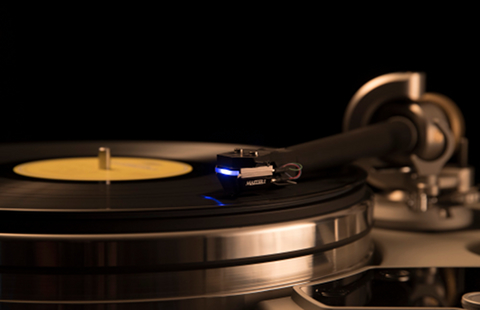about Audio, High Fidelity
& Home Entertainment technologies
pid: 607-2025/10/01 (v1.2)
Privacy Policy

Source: Press Release, Last Accessed: 2016/10/12
In 2013 DS Audio pioneered the world’s only optical phono cartridge, the DS-W1, which was an immediate hit in its native Japan. International distribution soon followed and now the company is proud to announce its new flagship, the Master 1.
DS Audio’s new flagship Master 1 features a number of significant advances over the company’s original DS-W1. During a two-year development process, every aspect of design and construction was re-evaluated and no detail overlooked, the company says.
The Master 1 uses a Micro-ridge stylus in place of Shibata and a sapphire cantilever rather than boron. A duralumin body provides exceptional rigidity, while an enhanced optical-mechanical system enables the re-designed micro-optic sensor to be placed closer to the stylus, resulting in a much shorter optical path length. In addition, the use of a wire suspended cantilever considerably lowers the compliance, making the Master 1 able to perform effortlessly at its best with a much wider range of tonearms (whereas the DS-W1 should be paired with a low-mass tonearm for peak performance).
The Master 1’s matching phono stage/equalizer features fully discrete dual-mono analogue circuits. To achieve flagship-level performance, each channel has its own dedicated power supply, while a third supply is dedicated to the cartridge’s LED drive system. Both single ended RCA and balanced XLR outputs are provided, with a choice of three subsonic filter settings.
The unit’s robust 24kg weight is the result of the twelve 120.000uf electrolytic capacitors and three transformers housed within. To achieve the lowest possible impedance, a pure copper bus-bar provides the optimal connection between them.
Optical cartridges aren’t new. Many audiophiles may remember them from the 1970s, when their performance was hailed as a radical step forwards. In contrast to moving-magnet (MM) and moving-coil (MC) cartridges that work on the principle of electromagnetic induction, an optical cartridge uses a beam of light to read stylus/cantilever movement. Supporters of this technology see a twofold advantage: it makes the cartridge much lighter and more agile, while also completely eliminating the frictional force caused by magnets and coils and the resulting influence on stylus/cantilever movement, while a further key advantage lies in the cartridge’s output. In conventional MM and MC designs, the output signal depends on the velocity at which a tiny magnet or coil moves in an electromagnetic field. At lower frequencies the magnet or coil moves slowly so the output signal is small, while at higher frequencies it moves more quickly and so the output signal is disproportionately large – hence the need for equalization. In contrast, in an optical cartridge the output signal depends on the distance that the styles moves, so there are no disparities between high and low frequencies. Therefore no equalization is required (other than RIAA curve correction) and low frequency reproduction is much enhanced, since an optical cartridge can theoretically detect signals as low as 1Hz.
For more information: http://www.ds-audio-w.biz/

